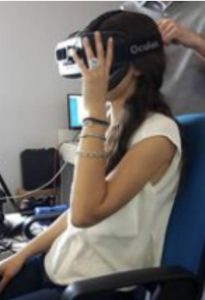A new study sugned by CoEHAR reserchers compared the reaction of young smokers to shocking images of a packet of cigarettes, those of a movie and those of virtual reality. The impact of latter is meaningful.
Catania, 17 October 2019 – Virtual reality, the most popular technological phenomenon among young video games enthusiasts addicted to interactive experiences, can be considered a valid support tool in quitting smoking and promoting pro-health behaviors, especially among the youngers. This is the result of the last research by CoEHAR, Center of Excellence for the Acceleration of Harm Reduction at the University of Catania, published on the prestigious international magazine Journal of Addictive Diseases.
According to prof. Pasquale Caponnetto, first author of the research conducted in collaboration with the Italian startup Behavior Labs: “The most important aspect underlined by this research is the connection of psychology to technology and the possibility of using the appeal of innovative technological system to encourage the access to a healthier lifestyle especially among youngers by using a form of language that they love, the technological one”.
Method
The researchers enrolled 40 young smokers between their twenties and thirties not motivated to quit and invited them to evaluate their motivation to quit after been subjected to three different types of motivational stimuli: a packet of cigarettes containing shocking images; a brief movie showing pulmonary effects of smoking and a virtual reality period based on the progression of smoking- related illness.

Results
Compared with the first assessments, all stimuli were significant in improving the motivation for smoking cessation. The difference between the stimulus of the packet of cigarettes containing shocking images and the movie compared to the one of the virtual reality is significant: the application to virtual reality would appear to greatly increase the motivation to smoking cessation.
Virtual reality is considered a sophisticated communicative interface, in which the user experiences the sense of presence, that is the existence (being there) which for the purpose of modern persuasions techniques better defines the attempt to change attitudes or behaviors.
To measure the results, iti is important to point out that the study participants, during the first evaluation, showed a 0 (zero) level of motivation to quit smoking on a motivational scale that ranged from 0 to 10. Once the post-stimulus scores were compared, a maximum level has been detected for the virtual reality stimulus. Specifically, the stimulus regarding the packet of cigarettes with a smoke-related disease image showed an average difference at the motivational scale of 3.91, the one regarding the movie stimulus was 4.87 and the virtual reality stimulus showed an average difference of 6.96.
“In order to defeat the use of conventional cigarettes, creativity must be introduced into science. Yes, because only by being forward-looking and knowing the specific lifestyle of the world’s population, it is possible to find the most suitable solution to solve the problem of smoking. The whole CoEHAR mission starts from here- explained Riccardo Polosa, Director of the International Research Center – technology and innovation must sign a strong and indissoluble pact of alliance to increase the motivation to quit smoking and to live healthy and free from slavery”.




